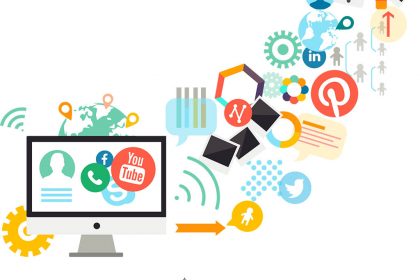Eight steps to scaling your content marketing using visuals
Though content marketing has become the primary way for small businesses to reach their clients and customers, content with visuals has been shown to make the biggest impact.
According to the latest marketing trends, of the pages that rank highest on Google, 97% include an image. If you want your business to be found, visuals have to play a part in your digital marketing strategy.
And the great thing about visuals is that they can help you scale your content marketing.
By using visuals, one piece of content can be stretched into several meaningful pieces that will boost your brand awareness and improve your sales over a shorter period of time.
If you still aren’t sure why you should be using visuals in your content marketing, here is a guide to how visuals can scale your content marketing in eight steps.
1) Clarify your visual marketing goals
Before we begin this exercise, you need to define what content needs visuals, and why. Look through your existing content and examine it with a critical eye.
You will find that not all your content requires visuals – some of it may have become too outdated to bring in any interest. Others may need too much reworking to be viable.
But you will find a number of published posts that would greatly benefit from the addition of visuals, or which could be repurposed as visuals.
Define what you want these visuals to achieve for you – to increase email click rates by 10%, or improve the recruitment process to reach five more candidates daily.
With defined metrics, you will find reporting on your new visual content marketing strategy easier to accomplish. This will help you examine what has, and hasn’t worked in your strategy.
2) Identify your target market

The visual content you create will appeal to certain kinds of people, and at particular stages of their customer journey.
You need to know who your audience is and when they will receive your content if you want to make a positive impression on them.
Creating customer personas is a great place to start in your scaling process—you will be able to better target your content and see higher results.
To create a user persona, you need the following points of information:
- Age
- Gender
- Income
- Interests
- Psychological profile
- Digital footprint
- Pain points
- Must-haves
It is best to give your personas a name, such as Susie the Spa Owner, or Greg the Grocer. This creates a personal connection between you and the user.
Once you identify your user personas, you also need to understand at what stage of the customer journey you will reach them.
The content you share to a user who is unfamiliar with your brand is vastly different to the content you create for users who you are retargeting.
Understand your audience and their needs, and you will be better placed to choose the visuals that will convert them into loyal customers.
3) Define your visuals
There are countless types of visuals available to you—from stock photos to original graphics. But which one works best for your strategy and for your audience?
Let us look at the most popular kinds of visuals, according to these content marketing statistics:
- Stock Photos
- Infographics
- Illustrations
- Videos
- Presentations
- Data visualization
- GIFs
- Memes
The array of visuals available to you is mind-boggling, and you may be tempted to use all of them in some way or other to scale your content.
But that will not be the best plan. Depending on the kind of business and target market you are aiming to attract, you may choose one or two that work for you.
For instance, you could find that infographics are great for attracting new customers who want to learn more about your brand.
On the other hand, infographics may not get you the impressions you want on social media that GIFs achieve.
If you have a thorough understanding of your audience and your visual marketing goals, you should be able to clearly define which visuals will work for your strategy, and choose accordingly.
4) Do keyword research
Did you think keyword research existed solely in the realm of content marketing? Keywords and search engine optimization (SEO) are an important aspect of visual marketing, as well.
Not only is keyword research a great way to generate ideas for content that can be scaled, but applying keywords to your visuals can improve your overall SEO.
When creating your written content, you will have conducted local keyword research for your content to rank on search engines.
You can use those keywords to help your visuals rank on search engines by incorporating them in these strategic areas:
- File name
- Title
- Alt-text
With the right keywords placed in the correct areas, your visual content will reach audiences organically.
5) Create branded visuals
In small and medium business branding is extremely important. Visuals with strong branding can improve brand recall immensely, and lead to more conversions.
But branding shouldn’t be confused with logo design – there are more elements of branding that should be reflected in your visuals, such as:
- Brand colors
- Brand fonts
- Brand personality
Your business can be just as noticeable with the consistent use of a brand color palette.
The same goes for fonts – if you use your brand font strategically in your marketing visuals, people will instantly recall your brand even if your name or logo aren’t mentioned.
And brand personality should always be highlighted in your visuals—through your tone of voice, your aesthetic, or the emotion you want to evoke.
By incorporating these brand elements in subtle ways, you can make a powerful statement in your visuals that will see your reach improve with even a single visual.
6) Use original graphics

Speaking of branding, one of the best ways to highlight your company’s unique personality is by creating original graphics.
While stock photos continue to be popular, they have already been shot with a particular purpose in mind. They are unlikely to showcase your brand the way an infographic, illustration, or diagram would.
However, you can use stock photos as the basis for more creative graphics. Include a stock photo in the background of your header or social media post and add text, icons, or color overlays to make the image uniquely your own.
Creating original graphics can be a challenge, but there are websites that provide highly customizable templates.
These sites allow you to create a wide variety of visuals in a short amount of time which are branded and unique.
7) Repurpose content
The primary point of this exercise of scaling content marketing with visuals is repurposing what you already have.
While adding visuals to existing content is one kind of repurposing, the visual content you create can also be repurposed. Consider using a digital asset management system for your team. The best DAM software has features that allow you to easily reuse materials for different projects.
A single infographic can be broken into different parts that can be shared as a social media campaign.
A series of blog posts or a presentation can be compiled into an eBook which you can use as gated content to increase subscriptions and site traffic.
Social media visuals can be repurposed as blog headers or email headers.
Videos can be made into GIFs that are easy to share on social media or to embed in newsletters.
The world of repurposing is as endless as your imagination and an excellent way to scale your visual content.
8) Analyze and repeat
You have done the hard work of updating the content you have with visuals, then used those visuals in myriad ways to reach new audiences. Now it’s time to see if the experiment worked.
Those goals that you defined at the start of this exercise will be your guide at this final stage.
How have the visuals helped you reach your target goals? Have your email click rates increased by 10%? Is your recruitment team reaching five more candidates than they previously could?
Look at how your content performed before the addition of visuals and compare that to its performance now.
Examine your social media impressions from before you started this experiment against your current impressions.
Once you have analyzed your data, you will understand what worked, and which areas require improvement.
With that knowledge, you can begin repeating the exercise to further scale your content marketing.
Ronita Mohan is a content marketer at the online infographic and design platform Venngage. She enjoys writing on various marketing-related topics and about using social media, improving conversions, best practices in writing, and how to be your most productive self.
Photo by Ashim D’Silva










